A 45 Minute Workshop Outline on Public Speaking with ImpaCCCT
I met Petra from ImpaCCCT when we presented at the first instalment of Disrupt HR this year. She invited me to share my tips on communication and in particular, public speaking to her Best Talents Meetup Group in the Brisbane CBD last week. And I only had 45 minutes.Phew, such an open topic! There are so many elements to public speaking. I didn’t really know where to start. Upon reflection, I’ve discovered a common pattern to the way I work when I’m asked to deliver a workshop or speech.Download a one-pager checklist that I use to craft any type of presentation.I used this one-pager as a focal point for discussion at the Meetup. This allowed me to give the audience direction, set expectations and also gave them a prompt to ask questions. What was interesting was how the questions that were asked directed the conversation to things I hadn’t even considered discussing that morning.
How the Meetup Started
 Yes, we met in a public space (a café), but that was no excuse. It was 8am and we began by warming up our voices. We all stood up, stretched our arms in the air, sighed, rolled our tongues, sang out some ‘la la la’s’ and introduced ourselves. We then shared what had brought us to the Meetup that morning and outlined details of the worst presentation we had ever seen.Warming up your voice is essential before speaking in any defining moment in your life. If you need tips, watch this video from Julian Treasure: How to speak so people want to listen.
Yes, we met in a public space (a café), but that was no excuse. It was 8am and we began by warming up our voices. We all stood up, stretched our arms in the air, sighed, rolled our tongues, sang out some ‘la la la’s’ and introduced ourselves. We then shared what had brought us to the Meetup that morning and outlined details of the worst presentation we had ever seen.Warming up your voice is essential before speaking in any defining moment in your life. If you need tips, watch this video from Julian Treasure: How to speak so people want to listen.
Mastering public speaking - it’s all about the ‘ouch’ moments
After warming up our voices, I shared the Ladder of Learning model. This is one of my favourite Learning and Development models that I use in a lot of workshops.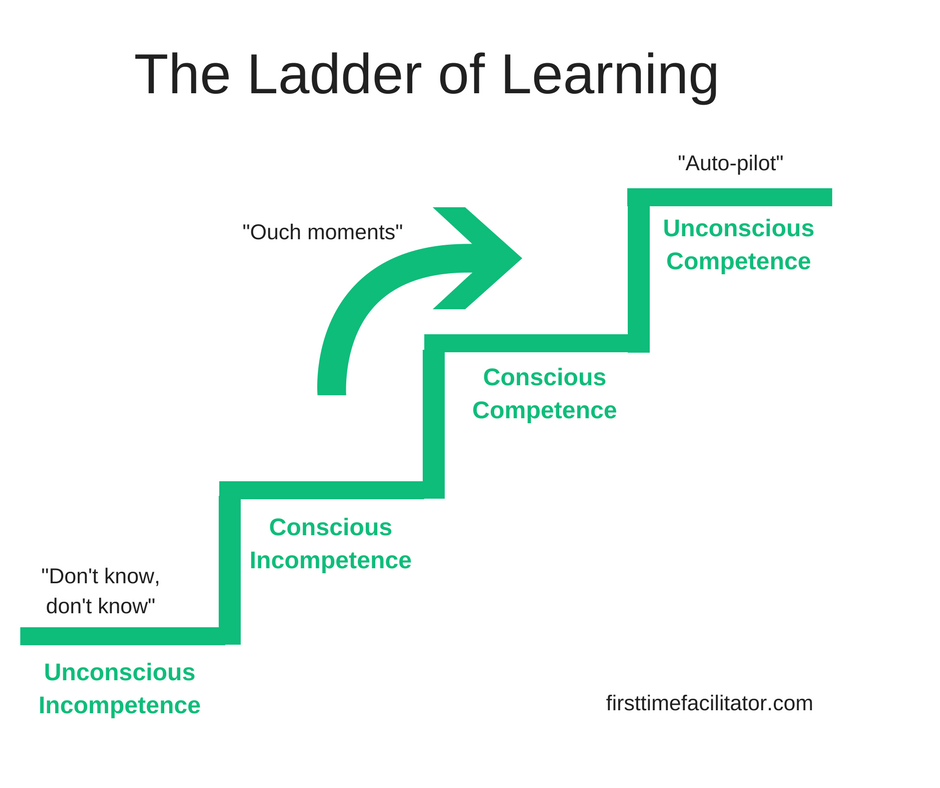 The model demonstrates that the key to any type of Skill Mastery is accepting (and embracing) that you’re going to experience ‘ouch’ moments - times where it’s really uncomfortable. Think back to the time when you were learning how to drive. It was extremely nerve-wracking and frustrating - particularly if you were driving a manual car and navigating a hill-start! It felt like mastering the skill of driving would never happen. Thought, it was worth the perseverance, because the rewards of driving were too great. Driving meant independence and accessibility; graduating to an adult world.It’s the same with public speaking. We can sit back, comfortably stagnant in the ‘Conscious Incompetence’ zone, or we can choose to invest, practice and tackle those ‘ouch’ moments to graduate to the ‘Conscious’, or even ‘Unconscious Competence’ status when we’re at the front of the room.What does the ‘ouch’ moment look like when it comes to public speaking?
The model demonstrates that the key to any type of Skill Mastery is accepting (and embracing) that you’re going to experience ‘ouch’ moments - times where it’s really uncomfortable. Think back to the time when you were learning how to drive. It was extremely nerve-wracking and frustrating - particularly if you were driving a manual car and navigating a hill-start! It felt like mastering the skill of driving would never happen. Thought, it was worth the perseverance, because the rewards of driving were too great. Driving meant independence and accessibility; graduating to an adult world.It’s the same with public speaking. We can sit back, comfortably stagnant in the ‘Conscious Incompetence’ zone, or we can choose to invest, practice and tackle those ‘ouch’ moments to graduate to the ‘Conscious’, or even ‘Unconscious Competence’ status when we’re at the front of the room.What does the ‘ouch’ moment look like when it comes to public speaking?
- Saying ‘YES!’ to speak when your immediate gut response is ‘NO!’
- The knots in your stomach the night/week before your big presentation (this is a good signal to buckle down and ensure your preparation is spot-on).
- Attending a Meetup about Public Speaking.
New contexts or environments can sometimes slip us down the ladder
I’ve learnt that a change in context or environment can force a slip down the ladder. Again, an example I used was driving. In Australia, I see myself in the ‘Unconscious Competence’ sector - when I drive, I feel like I’m on autopilot. However, when I traveled to Canada earlier this year I slipped back into ‘Conscious Competence’ where I was actively thinking about every action I took when I was in the driver’s seat. I even had a post-it note on my steering wheel reminding me which side of the road to stay on.It’s the same with presentations. Over our career, we can be comfortable presenting in front of the same audiences and in the same room (‘Unconscious Competence’) and suddenly you’re wheeled in front of the Board. The stakes are higher and your nerves are heightened - which may have you slipping back into ‘Conscious Competence’. This isn’t a bad thing - it’s great and gives you more ‘ouch’ moments, which will help you improve over time. To evolve as a public speaker, look for opportunities that are at the next level and continually challenge you.
What about the most high-stakes environment of all time, the dreaded job interview?
An environment where the pressure and stakes are at an all-time high is the job interview.A couple of participants attending the Meetup were in job-hunt mode and were quite early on in their careers. In many job interviews, you’re asked to provide examples of situations where you have demonstrated a particular skill. We have all been asked a question that starts with, ‘So, tell me about a time when…’.My advice is to start collating story examples early in your careers. I would use a simple template like this one:[table id=2 /]If you start collecting your life experiences and transcribing them into a simple Google Sheets table, you can weave them into any presentation - not only the job interview. In future when you’re writing a speech you then have a database of some personal anecdotes you can utilise to demonstrate a point. This is gold. It’s very tricky thinking of those stories off-hand.You can even start a folder in your inbox called ‘Stories’ and drag emails that remind you of a great story to this folder as an even easier way to start.We spent the remainder of time talking through the one-pager handout which included the following information split into three major categories:
- Preparation.
- Crafting your content.
- Presenting with power - for more tips, view my article Disrupt HR: The Creative Process in 7 Simple Steps
[table id=1 /]Download a one-pager checklist that I use to craft any type of presentation.If you’re in Brisbane, join the Best Talents Meetup group and join us for a monthly coffee and 45 minutes of top content!
35 Lessons I Learnt at the ‘We Are Podcast’ Conference
A few months ago I was cruising Eventbrite, having a look to see what events were coming to Brisbane and I saw an event titled We Are Podcast. Curious, I clicked the link and couldn’t believe the speaker list - podcast celebrities from the US who I frequently listen to on my daily commute; the likes of Jordan Harbinger from Art of Charm and John Lee Dumas from Entrepreneurs on Fire.I don’t have a podcast (yet) but I thought it would be an interesting way to learn about this medium. Without thinking about it too much, I paid my $690 registration fee, asked the boss for annual leave… and I was in.What a great decision. I’ve summarised the top three things I loved about the conference and also included a list of the top 35 lessons I learnt.Author's note, this is an informative post capturing my key notes from the conference, without too much reflection on what I'll do with them - more on that in future articles!
1. Putting the ‘Present’ into ‘Presenters’
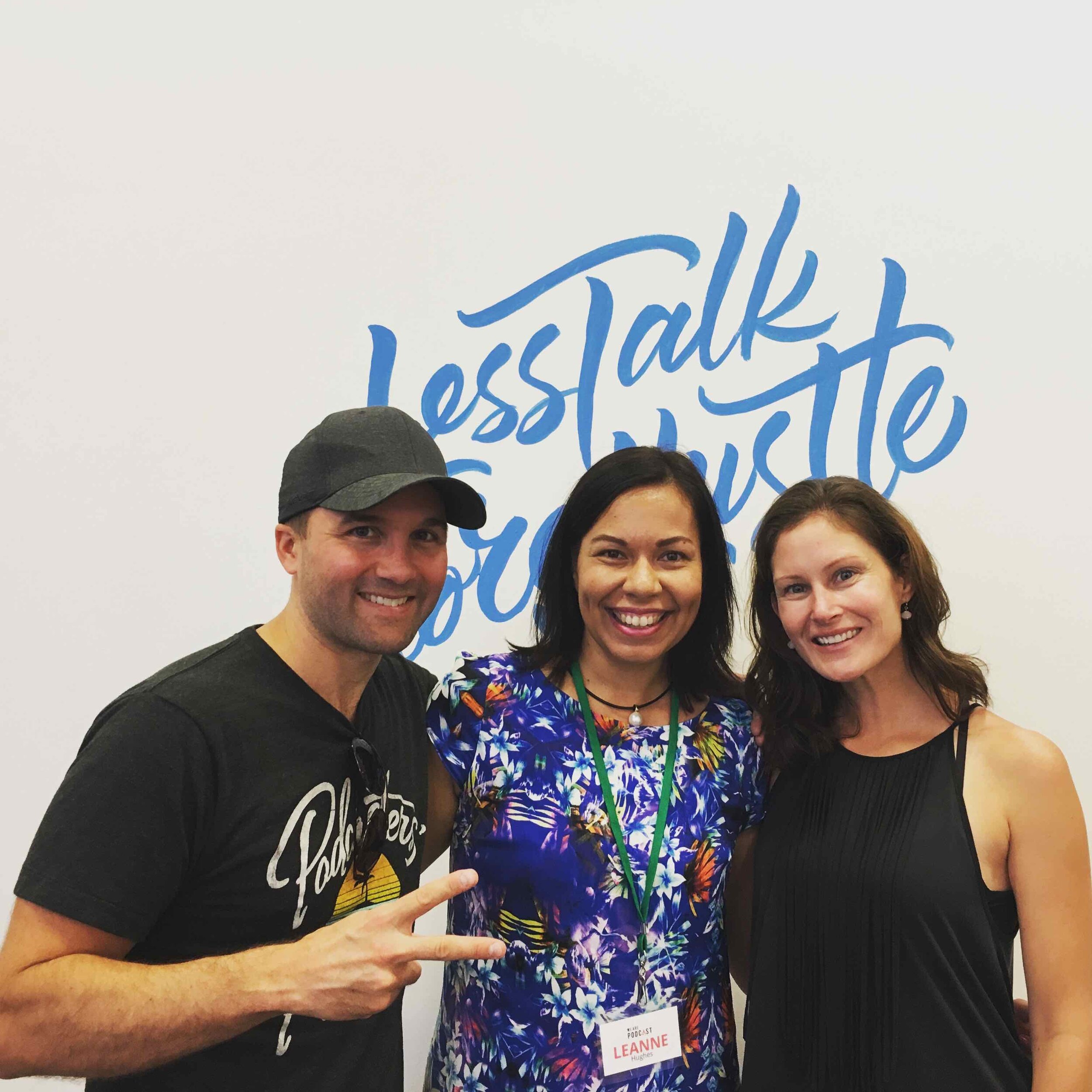 I’m used to attending conferences where the keynote speaker arrives five minutes before their spot, gives a pearler of a speech and then shoots off in a flurry.The biggest and best surprise about this conference is that the presenters hung around and they were accessible - you could walk up at any time for a chat. The chats weren’t one-sided either, they were genuinely interested and asked what you were up to and offered tips/advice. Thanks guys.
I’m used to attending conferences where the keynote speaker arrives five minutes before their spot, gives a pearler of a speech and then shoots off in a flurry.The biggest and best surprise about this conference is that the presenters hung around and they were accessible - you could walk up at any time for a chat. The chats weren’t one-sided either, they were genuinely interested and asked what you were up to and offered tips/advice. Thanks guys.
2. A Light and Bright Venue
I know there were some headaches with the audio, however, 5 stars to Fishburners as a conference venue. It’s centrally located, there are stacks of restaurants and pubs nearby, lots of natural light, cool break-out rooms and funky decor.I also liked that we weren’t thrown in like cattle and had to sit all facing the stage lecture-style. The conference room was setup cafe style, which allowed for easy conversation and note-taking.
3. Friendly, Community Vibe
Simon Sinek says ‘The leader sets the tone’ and I believe the architect behind ‘We Are Podcast’, Ronsley, reflected his brand and personality over the three days by creating a fantastic community vibe.The feeling in the room was casual and inspired; he hired a really great Master of Ceremonies, all of the staff members wore bold ‘Just Be’ black shirts and it was really easy to walk up to anyone and have a chat about their podcast, business, life.This was reinforced by the coolest roaming microphone I’ve ever seen - one that you can throw and catch to get questions from around the room. I had a look and you can buy it from GetCatchBox.
Here are the top two things I learnt from each speaker.
Day One: Workshop
A recap of the three workshops I attended on the first day.
Nicole Baldinu from the $100 MBA: Podcast Production Fundamentals
1. There are three key things you need to do when you decide to start a podcast. Nicole used the $100 MBA as her examples - I’ve included these below in italics.
- What’s the goal? Is it sales, engagement, to grow your community? (To teach real world business lessons)
- Determine the format of the podcast - interview format, quick tips, etc (Lesson-based, short format)
- Describe your show in one sentence (Daily, 10min lessons for the real world)
2. To create a point of difference, have a look at the other podcasts in the iTunes library for your category. Figure out how you can differentiate or add more value.
Stephanie Holland from Amplify: Amplify Your Product Launch
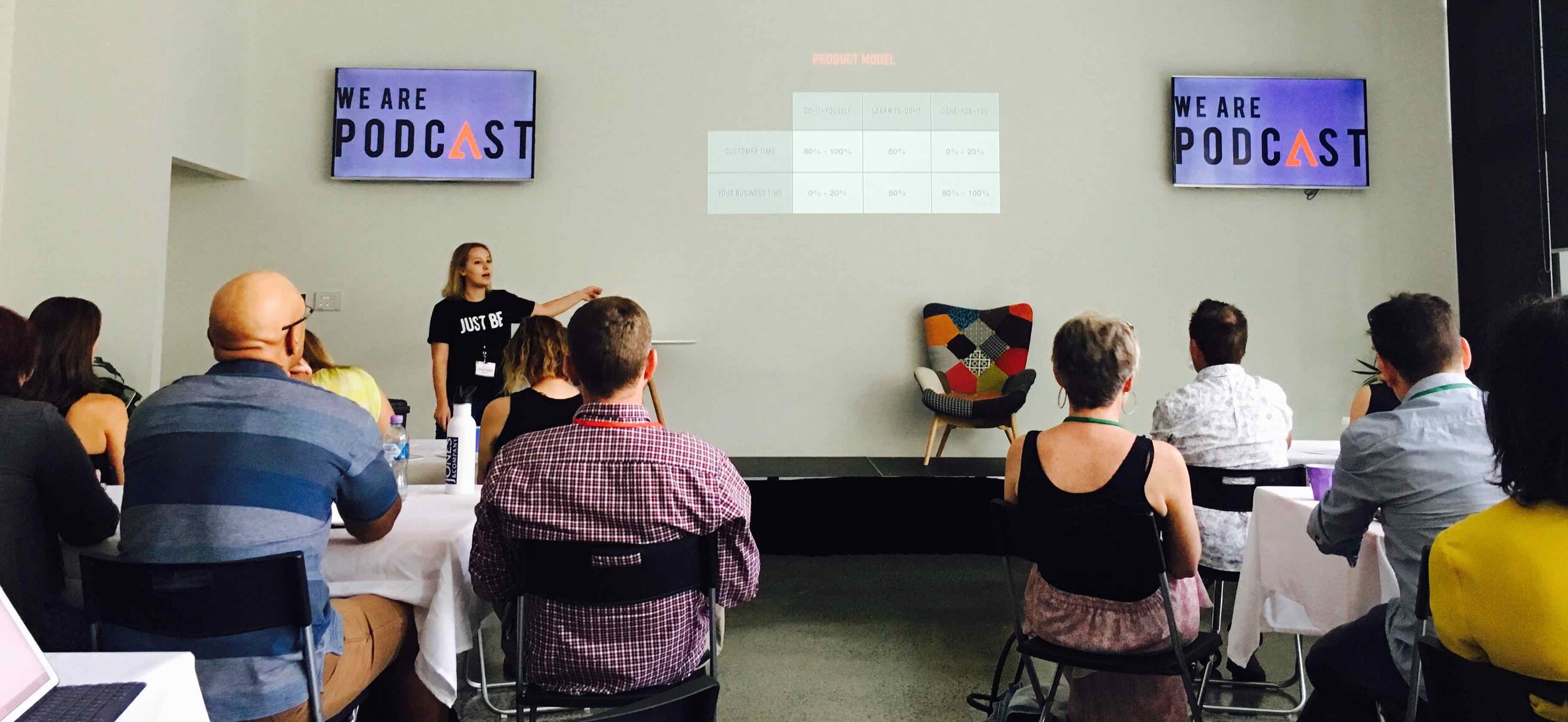 3. Think about your product. If you offer a 1-to-1 product offering, how can you scale it? If you offer a 1-to-many product, how can you engage 1-to-1 high profile/high paying clients?4. Zero Moment of Truth (ZMOT) - People read ten pieces of content before they buy from you (Author’s note: I can 100% relate to this - I bought the Apple Watch Series 3 on Thursday and read about 10 articles before making that purchasing decision. I would also add that the number of articles you read is proportional to the cost of said product)
3. Think about your product. If you offer a 1-to-1 product offering, how can you scale it? If you offer a 1-to-many product, how can you engage 1-to-1 high profile/high paying clients?4. Zero Moment of Truth (ZMOT) - People read ten pieces of content before they buy from you (Author’s note: I can 100% relate to this - I bought the Apple Watch Series 3 on Thursday and read about 10 articles before making that purchasing decision. I would also add that the number of articles you read is proportional to the cost of said product)
Jason M from the Portrait Store: How to take the ultimate headshot selfie
5. Do the turtle - lengthen your neck when you take a selfie and keep your chin down.6. Connect with your audience. Instead of holding the camera up high, keep it at eye level. Don’t look into the glass… find that little hole at the front of your mobile, the camera lens and look all the way into it.
Day Two: We Are Podcast Conference
Andrew Griffiths: Master of Ceremony
7. He set the tone brilliantly - nice and relaxed, had a lot of information to cover but made it fun8. Reflected really well on what was being taught on stage, summarised it neatly, added his own stories and experiences to emphasise key speaker points.
John Lee Dumas from Entrepreneurs on Fire: Podcasting with a Purpose
9. Before you funnel down, you must funnel up - niching down is important. It’s lets you dominate that niche and get the momentum going. For example, as a social media marketer your target audience could be male dentists, based in the Brisbane area. Once you dominate this niche, you can look at broadening your audience to female dentists, dentists based in Sydney, etc.10. Have one avatar - this is the avatar that is going to serve you the most. JLD’s avatar is a guy named Jimmy, mid 30,s who spends 25mins driving to work in the morning, spends 9 hours in a cubicle for a job he doesn’t like (35mins on the way home cause of traffic) and all Jimmy wants to do is go fishing. When you need to make a decision in your business, think ‘WWJD’ - What Would Jimmy Do?
Sean DeSouza from Psychotactics : Pre-sell: How we Sellout Products/Courses in Mere Hours
11. He started a business because he wanted control - he defined control as a state of freedom from worry about income. Over the last 17 years, he and his wife have had 3 months worth of vacations every year. He calls it - ‘downtime by design’. (Author’s note: Hear, hear!)12. He spoke about the importance of the pre-sell (‘People buy before they pay) and used the metaphor of an upcoming wedding to use as the format for your pre-sales (i.e. give away high level details and stagger these announcements over time).13. His secret weapon is sending physical product to his clients - it’s incredible what a personalised cartoon postcard and a box of chocolates can do!
Glen Carlson from Key Person of Influence: Assets of Influence
14. He highlighted proximity bias and that we tend to devalue the things that are close to us (I think this links into imposter syndrome). He likened this to our relationships, our thoughts and ideas.15. He said that any stress, frustration or bottle neck can be traced back to an asset deficiency. Give your teams/people more or better assets - don’t throw more money or time at your team’s problems, ask yourself the question: ‘What’s the missing asset?’.
Louisa Dahl from Interactive Minds: How to position yourself as an in-demand expert
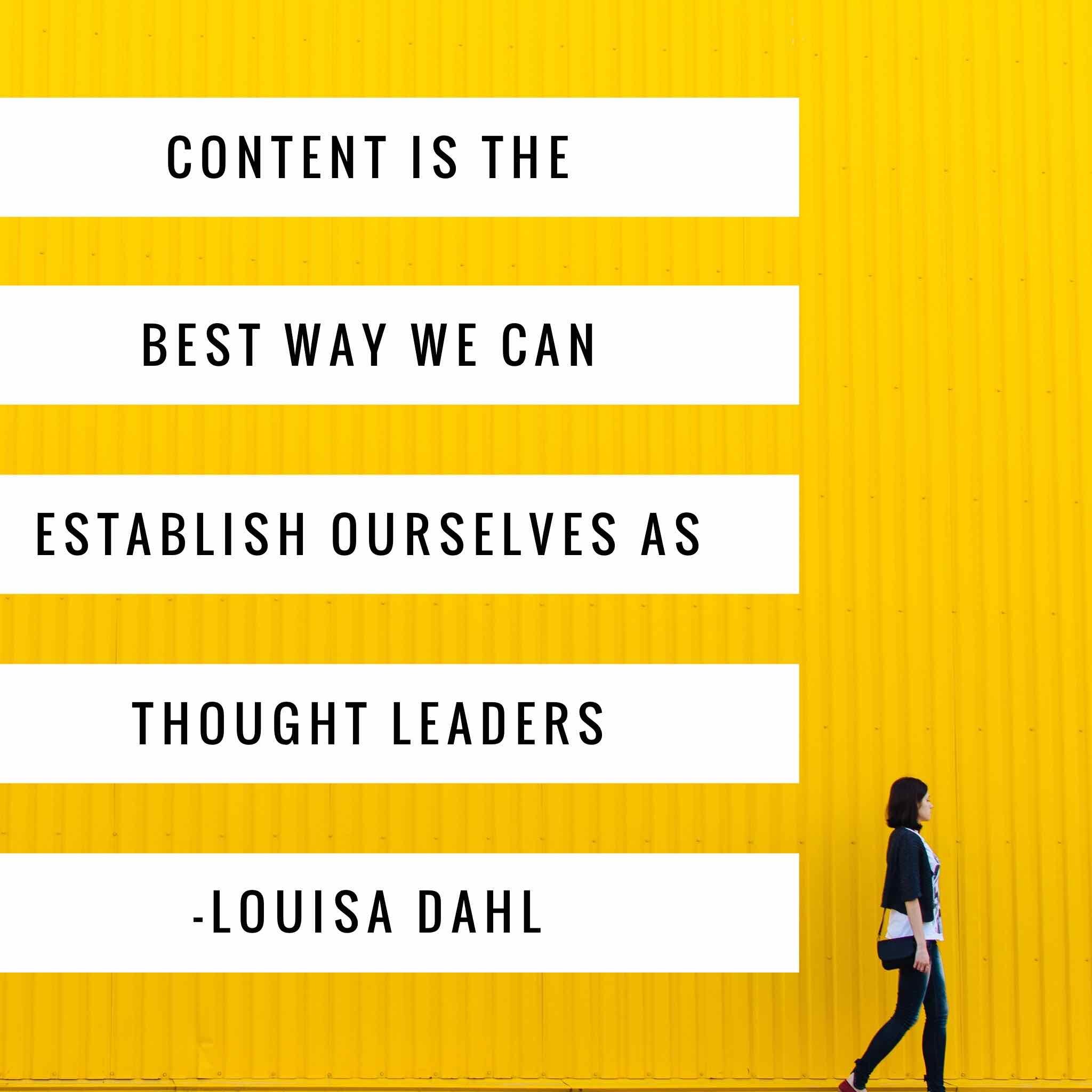 16. Think about your results and ask yourself how to make it real. For example, ‘How many widgets do I need to sell to make my own salary?’17. Content is the best way to establish ourselves as thought leaders.
16. Think about your results and ask yourself how to make it real. For example, ‘How many widgets do I need to sell to make my own salary?’17. Content is the best way to establish ourselves as thought leaders.
Clarissa Rayward from the Happy Family Lawyer: From Lawyer to Podcaster - Turning a traditional business on its head through podcasting
18. Build fast, fail fast - do the do. If you have to think of an idea, try ‘speed-thinking’ and giving yourself a tight deadline to make it happen. She provided a great example: If you need to go to work at 8.30am and you wake up at 8.20am… you still find a way of getting ready in time. Use the same thinking to get things done.19. Mindfully pay attention to the feedback that you’re receiving…there may be something in it.I had to leave the conference after this event at this stage to be the Master of Ceremonies at an awards night, so I missed the last few presentations from Danielle Lewis, Nathan Chan and Kate Erickson. But I had a great night’s sleep and was full of energy when I arrived for the final day.
Day Three: We Are Podcast Conference
Ronsley Vaz from Amplify: Product Ecosystems - Content assets and customer journeys
20. The question isn’t how to grow… it’s how to grow efficiently. This involves an overlap of Convincing, Converting and Automating your customers/systems and processes.21. Treat your customers like an intimate relationship - you don’t ask someone to marry you when they first meet you, so stop aggressively sell them stuff! Work your way through four stages:
- Attention (Solve a headache)
- Engagement (Remove obstacles)
- Sales (Address an aspiration)
- Client (Pursue a desire)
Amber Hawken - The Skill of Selling from your Soul
After busting out the macarena, we learnt to:22. Remember that when you are doing anything (particularly podcasting) - it’s not about you. It’s always about your audience.23. Our heads feel fear and rejection. When you’re working on your business, try to get out of your head and just be/do/create.
Omar Zenhom from Webinar Ninja
24. We need to incorporate Webinars into our marketing efforts for three reasons.To:
- Collect emails
- Create trust as it’s a two-way conversation
- Grab attention - You can do similar things on Facebook Live, but Facebook is full of distractions; where as webinars are a controlled environment.
25. You create your webinars for three different types of audiences:
- Never heard of podcasting
- Never heard of your podcast
- Have listened to a podcast but haven’t subscribed.
Yann Ilunga from 360 Entrepreneur: Podcast to Virtual Summit
26. He outlined how to use your summit to build your audience and to approach promotion of your virtual summit like a music festival.27. He brought up a great point about making it easier for your summit guests to promote their interview by sending them Canva images and spiel.
Emma and Carla from The Merry Maker Sisters: Five things we’ve done to create an awesome, loyal community
28. Treat your community at the same level as you. Value your brand champions.29. They’re successful as they have fun. They evaluate an idea and if it doesn’t make them excited, the idea is benched.
James Tuckerman from Not So Freaky University: The 12 Principles of Persuasion and Influence
I won’t outline all of the twelve steps but my favourite ones were:30. Clarity booster - you can describe this in three different ways:
- Outcomes
- Things (most people say this
- Feelings
For example, you say you’re in the business of ____ (things). But, all your customers really want is a ‘fist-pumping moment’ (a feeling). It’s important to identify all three.31. De-risk it - Highlight the potential Return on Investment - but talk more in terms of the potential cost of inaction. This is what drives 80% of action. For example, would you be more motivated to run towards a cuddly bear; or run away from a grizzly bear?
Michael O’Neil from the Solopreneur Hour: The Art of the Interview
32. When you introduce your guests, the last two words should be their name (example, ‘…She’s based in Brisbane and I’d like to welcome award-winning author, Jane Smith).33. You want your guests to talk in stories. His all-time favourite question to ask guests is ‘What does your child-hood smell like?’ as this evokes feelings and stories that you can often relate to through the interview.
Jordan Harbinger from the Art of Charm: How I learnt to network from getting kidnapped
34. Put 1-2% of your salary into a ‘holding fund’ so if an amazing conference comes up which involves travel/cost - you can attend through proper planning.35. The best value is not in your bank account - the best value is your network. List the top 10 people you would contact if you lost your job tomorrow. How are you keeping in touch with them and offering them value? Always give value.
On another note...
Funny story. MC Andrew announced that there would be a lucky draw prize on the third day. All you needed to do was write down your name, your podcast title, what it was about and pop this in the draw. I don't have a podcast but I entered anyway. My philosophy was 'If I get selected, then it's a sign that I need to start it'. At the end of the day, my idea was plucked out of the draw! Crazy. Guess I better get to work so I can report back to Ronsley and the team at We Are Podcast 2018...Do you agree with these podcasting and business tips or have any more to add? Comment below![contact-form][contact-field label="Name" type="name" required="true" /][contact-field label="Email" type="email" required="true" /][contact-field label="Website" type="url" /][contact-field label="Message" type="textarea" /][/contact-form]
We’re Still Standing! Drawing leadership insights from Elton John’s concert in Cairns
I travelled to Cairns this long weekend to see Elton John play at Cazaly’s Stadium. I was fortunate and excited to have a front row seat – Seat 1A! When the music started, a few of us began to stand and dance in our seats but were quickly told by security guards to sit down. As the concert progressed, more fans were migrating closer to the stage and dancing along to the infectious tunes.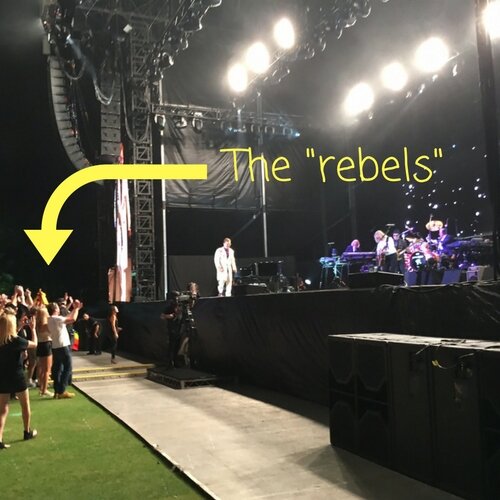 It was becoming harder and harder for security to stop us. At one point, there were about 30 people at the front dancing along to Elton’s iconic songs – how could you not? Shortly after witnessing the security guards’ feeble attempts to control the crowd, Elton barked out “For goodness’ sake, let the people stand! This is a rock concert – not a protest!”
It was becoming harder and harder for security to stop us. At one point, there were about 30 people at the front dancing along to Elton’s iconic songs – how could you not? Shortly after witnessing the security guards’ feeble attempts to control the crowd, Elton barked out “For goodness’ sake, let the people stand! This is a rock concert – not a protest!”
Well, when Elton talks, people listen.
Immediately that message from the top opened the floodgates. Hundreds of people swarmed to the stage and the atmosphere in the stadium amplified, with the band feeding off of the delight of the crowd.
How does this relate to leadership in business?
In Simon Sinek’s TED Talk, 'Why good leaders make you feel safe’ (video below), he discusses leaders setting the tone and the environment (or ‘level of safety’) that employees feel within an organisation. When employees on the ground have high trust/safe environments, they feel empowered and supported to make their own decisions.
The security guards were following their direct leaders’ instructions to ensure the safety of everyone at the stadium. They were doing their absolute best to prevent fans from swarming upfront. The ‘threat’ that we felt in the crowd was that if we were to dance/stand up too many times, we may be ordered to leave the event.However, it took only one sentence from the ‘organisation’s’ principal leader, Elton, to set a new standard. By telling us we were allowed to stand, he instantly changed the environment to one where we felt safe to dance, sway and twirl without the threat of eviction hovering over us.I spoke to the security guard following the event and asked how he felt in that moment. He laughed and shook his head, saying “It was impossible to reinforce our directions after Elton’s call”.It made me think about middle managers in organisations who believe they are doing the right thing (by reinforcing a directive they have been given) and the confusion and frustration they may feel when a more senior leader talks directly to their team and changes the environment they are responsible for.It’s almost as if the managers are stripped of their credibility to continue the job they were tasked with, as they have essentially been overruled and undermined. It may cause them to throw their figurative arms in the air, thinking ‘What’s the point?’ The other interesting question this scenario raises is, why are middle managers reinforcing behaviours that are not supported by the organisation leaders? Where/when/why is the message lost in translation?
What else did I learn?
Another thing I loved hearing is that the band’s 66 year old lead guitarist, Davey Johnson, has played over 2,800 gigs with Sir Elton. He and his band-mates are still having the time of their lives on stage, playing music together like it was their first time. You feel that energy and passion coursing through your own veins. It’s truly a joy to go to these gigs and watch people publicly display the love they have for their job – it’s their life’s purpose.And if you ever get the chance to see Elton play, do it! It was the best gig ever. Oh, and thanks for the guitar pick, Davey!
Disrupt HR: The Creative Process in 7 Simple Steps
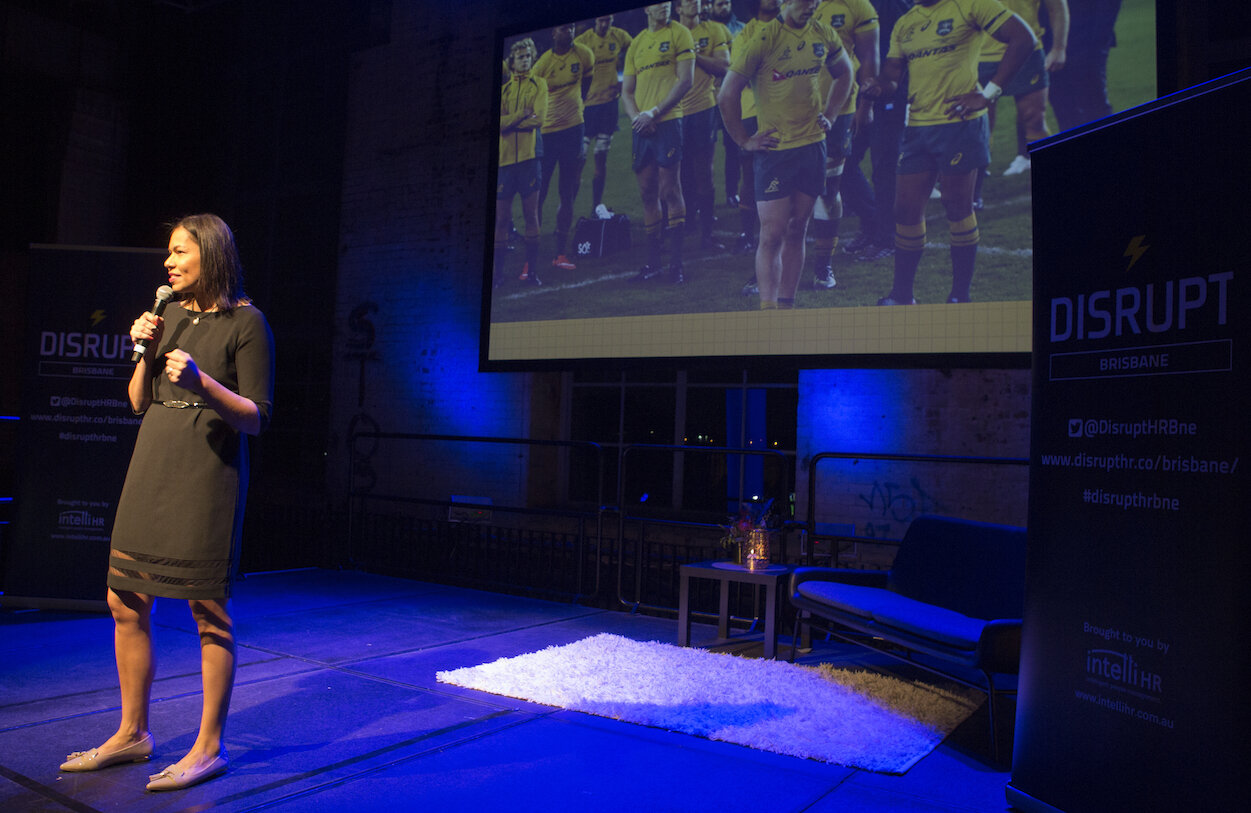 Last month I was up in lights at the Disrupt HR event in Brisbane. It’s the first time the event has been brought to sunny Queensland and the HR Community in the river-city came out in their droves, to hear from nine diverse speakers about the Future of Work.The format for the presentations is fast and furious – 20 slides with only 15 seconds spent on each slide. That’s 5 minutes to ignite some interest in the audience, lead them down the road with a story or personal anecdote, throw some stats around and inspire them to take action. Yes, it’s a tough gig.Here’s the video of my presentation ‘How one switch can improve your nine-to-five'’. I spoke about something really simple - office furniture, in particular, the sit-stand desk and its impact on productivity and quality of work life.How One Switch Can Improve Your Nine-to-Five | Leanne Hughes | DisruptHR Talks.When you write for Disrupt HR, you really need to consider your topic. I learnt a lot while preparing for the stage and thought I’d share my tips.But before we start, I want you to put yourself in the ring and:
Last month I was up in lights at the Disrupt HR event in Brisbane. It’s the first time the event has been brought to sunny Queensland and the HR Community in the river-city came out in their droves, to hear from nine diverse speakers about the Future of Work.The format for the presentations is fast and furious – 20 slides with only 15 seconds spent on each slide. That’s 5 minutes to ignite some interest in the audience, lead them down the road with a story or personal anecdote, throw some stats around and inspire them to take action. Yes, it’s a tough gig.Here’s the video of my presentation ‘How one switch can improve your nine-to-five'’. I spoke about something really simple - office furniture, in particular, the sit-stand desk and its impact on productivity and quality of work life.How One Switch Can Improve Your Nine-to-Five | Leanne Hughes | DisruptHR Talks.When you write for Disrupt HR, you really need to consider your topic. I learnt a lot while preparing for the stage and thought I’d share my tips.But before we start, I want you to put yourself in the ring and:
Back your experience and your public speaking ability - then DO IT. Submit your application.
When I read on LinkedIn that Intelli HR were bringing the event to Brisbane, I thought ‘Geez that event looks interesting! I’ll DEFINITELY grab a ticket and tell my colleagues all about it too’.A few minutes later, my thoughts changed to, ‘Hey…I think I could actually speak at this thing’. I resonated with the tagline of the event: ‘DISRUPT is an information exchange designed to energize, inform and empower people in the HR field.’I love all things disruptive, so I expressed my interest with the event organisers, told them a bit about myself, outlined a couple of topic ideas and then forgot all about it.A few weeks later I received the call up. I was locked in to the program. And I was terrified.
Why did I sign up and why do I recommend you do the same?
I recently listened to this podcast from Pat Flynn – ‘Why you belong on Stage – Pat’s “braindump” of public speaking and presentation tips’. He explains how public speaking changed his life (how it helped to build his personal brand/credibility, led him to new opportunities, and opened his door to meeting other influencers), and other compelling reasons that will have you on the stage in no time. I recommend you plug in those headphones, go for a walk and listen to Pat’s wisdom. But if you don’t have that much time than this image pretty much sums it up: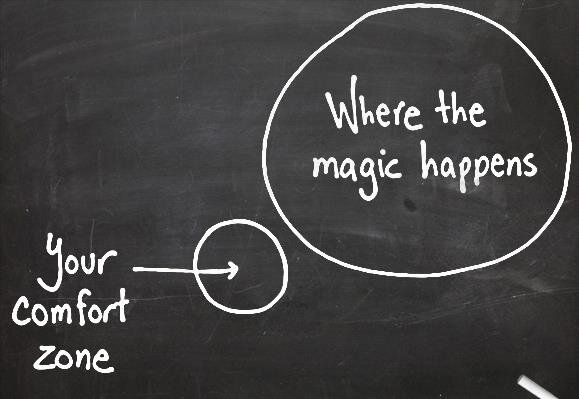 You may be thinking 'I don’t know what to talk about', 'I don’t have credibility in any particular HR niche', 'I can’t memorise my speech' or 'I’m not creative'.And guess what? That’s completely normal. Most (if not all) speakers up on stage have had these thoughts at some stage in our career. It's whether you choose to ignore them and forge ahead, which makes all of the difference.Through this process working on my speech, I went through all stages of the change cycle. Denial, particularly, which manifested in the form of procrastination. Six weeks out I needed to submit my topic idea and a brief descriptor.Here’s a little wrap-up of the 7 step process I went through to deliver my Disrupt HR speech, from topic generation through to performance.
You may be thinking 'I don’t know what to talk about', 'I don’t have credibility in any particular HR niche', 'I can’t memorise my speech' or 'I’m not creative'.And guess what? That’s completely normal. Most (if not all) speakers up on stage have had these thoughts at some stage in our career. It's whether you choose to ignore them and forge ahead, which makes all of the difference.Through this process working on my speech, I went through all stages of the change cycle. Denial, particularly, which manifested in the form of procrastination. Six weeks out I needed to submit my topic idea and a brief descriptor.Here’s a little wrap-up of the 7 step process I went through to deliver my Disrupt HR speech, from topic generation through to performance.
Step 1. Topic choice
By far, for me this was the trickiest of all the stages. I read a lot of blog posts and article on which topic to choose from and spent a while fleshing out ideas using mind maps.My criteria was that I wanted a topic which was fairly pragmatic, meaning that it was useful for the audience and they could take practical action the minute the speech was over.However, after listening to Michael Port’s podcast, ‘Steal the Show’, I realised that I was going about this all the wrong way...
The real Step 1 is: Profile the audience
The event isn’t about you, it’s about serving your audience and determining what’s in it for them.Think about the type of people that will attend an event like this. The brief attracts a local HR professional type audience. Think of a HR professional, one person in particular and profile their demographics - gender, age, education.Map out their career needs, fears, wants and frustrations.Think about:
- Why they’re attending a HR event after a long day at the office, when they could be spending time with their family.
- Why they’re attending an event that talks about disruption.
The key here is to not think about this criteria too broadly, you really want to target one person. As you work in the HR space, think of a colleague or boss that you could profile.Through this process, I realised that the majority of HR Professionals still work in an office environment and there are common concerns associated with that, such as our lack of movement and collaboration when you sit in the same spot, every day.This linked into something I’m passionate about - which is physical activity and how standing up while working can make you feel great, as well as lift your levels of innovation, collaboration and efficiency.You really don’t want to spend too long in the topic choice stage. Once you’ve made the decision, commit to it and cut off all other options. You still have a lot more work to do.
Step 2: Researching the topic
At this stage you want to use a range of sources, such as:
- Your own personal anecdotes and experiences (start thinking of interesting stories related to the topic)
- Data/research/stats to support your idea - Spend a couple hours on Google- I’d recommend both academic articles and also researching interesting blog perspectives.
- Chatting to other people on their thoughts to validate your topic
- Podcasts related to the area (makes it easier when you’re commuting/walking/don't have time to sit down and read)
I spent a few hours over two days, gathering all my stats, quotes and information together. With all of the information collated, I realised there were three broad themes to address;How sit-stand desks improve:
- Your health
- Your productivity
- Your levels of collaboration in an open-plan office.
Step 3: Drafting the speech
I spent most of my time in this phrase, writing and re-writing content, deleting, adding, tweaking and re-inveting… this is unavoidable.The good news is, that the PowerPoint slide auto-advancing speech format isn’t new. I drew inspiration from blog articles based on the Pecha Kucha format (20 slides x 20 seconds), particularly this one: Your Ultimate guide to giving PechaKucha presentations’.I also drew inspiration from the book The Presentation Secrets of Steve Jobs: How to Be Insanely Great in Front of Any Audience (Business Skills and Development) by Carmine Gallo. In the book, Gallo outlines how Steve Jobs used to sequence his big product talks in ‘rules of three’. He also used simple, visually powerful slides and he used stories to create ‘pain points’. After setting the audience up, he then offered the audience a solution to these problems (eg. the iPhone).As your speech time is limited, you need to use your visual slides to support/amplify your key messages and arguments. To plan this, I drafted my speech in a table with the following column headings:
- Slide number (1-20)
- Topic (eg. How sit-stand desks support Health)
- Content (data, stories to support stories)
- Slide image ideas (visual elements that make the content come to life)
I calculated my speech pace at 900 words over 5 mins (pretty quick) and I had written 1800 words. Cutting back was tough - it’s a balance of giving the audience enough to understand your message; but nothing too prescriptive that you’re spoon-feeding them.I dedicated 40% of my speech to setting the pain point (how our lack of movement is slowly killing us). The remainder of the speech was offering a solution. I also spent two slides opening up the presentation talking about something completely unrelated to the topic, the Wallabies recent form in the rugby league. This was to draw the audience in and to start them thinking 'How on earth does this relate to us?'How to defeat that writer's block? My tip for writing a speech is to pretend you’re writing for the rubbish bin. You just need to get those thoughts down, no matter how ridiculous and lame they sound at the time. From there, you can edit – add, tweak, adjust as needed, but building momentum is important.While drafting the speech I was also open to incorporating other concepts (especially after listening to Michael Port’s interview with Neen James on creating contextual models). I listened to another podcast where Michael Port interviewed author, Jonathan Fields. Jonathan was introducing his Good Life Project. He spoke about all of us having three buckets in our lives - our Contribution, Connection and Vitality buckets. I loved the law of the buckets and realised it was the perfect contextual model to align with my topic.I raced back home that night and read more about from Fields on How to Live a Good Life: Soulful Stories, Surprising Science, and Practical Wisdom
Step 4: Create powerful slides
I think slides are an element that speakers don’t prepare enough for/are understated.Remember, each slide flashes only for 15 seconds, so the slide must be strong, less words (or words with impact), bold, large visuals.Limit collages. Limit low-resolution files. Limit the clip-art.Each slide must support your argument and draw your audience in.Another simple tip - keep a simple visual theme weaved throughout the presentation. I chose a theme through Canva to design my slides.
Step 5: Do your first paper reading
Once you’ve drafted the speech, Michael Port suggests you do a ‘paper reading’. This is where you print your draft speech notes out, sit at your dining table and read your script aloud in a normal voice. This is a really useful exercise where you can determine which words/phrases feel comfortable off the tongue and sound authentic to you. You can extend this further and start ‘blocking’ your speech. This means, highlighting words where you’ll pause, increase volume and change tone. You can also block your movement - such as walking at a specific time, where you'll move your arms to emphasise a point, etc.Once you’ve done a couple of these, lock that speech down and move onto…
Step 6: Rehearse, rehearse and rehearse…Then, rehearse again
If you present at one of these gigs, the biggest challenge is that you can't take speech notes on stage.I don’t know any quick memorisation hacks. For me, it was all about practising when I had the chance. One practical tip I recommend is to record your speech into your Voice Memos iPhone app. I did this and would play it back when I was driving, out for a run or walking the dogs - it was an effective way to rehearse along.When I was getting the ‘hang’ of it, I’d start rehearsing from a quarter/half the way through the speech.I also recommend rehearsing in front of a trusted advisor. I’m lucky I work with a fantastic, HR professional (thanks Jordana) who gives excellent and honest feedback. The external validity and advice gives you confidence that a) You’re on the right path or b) Yes you need to tweak some things but you'll be good on delivery day.
Step 7: Showtime
Try to get a good night’s sleep the night before your performance!I didn’t rehearse too hard on the day, as I knew the time I had invested leading up to this moment had served me well. All I was focused on before the speech was staying relaxed, warming up my voice, and reminding myself to enjoy the moment.One of my favourite videos that I show anyone I help prepare speeches with, is this TED Talk from Julian Treasure – I usually start it from the six minute mark.Pat Flynn said that it's important to arrive early and mingle with your audience. He learnt this from Dale Carnegies’ book ‘Stand and deliver’. The purpose of this is two-fold:
- You connect with you a couple of people so it doesn't feel like you're presenting in front of a bunch of strangers (no longer as strangers)
- The audience members think it’s pretty cool that they’re meeting someone who is about to walk on the stage.
Conclusion
Phew! A lot of tips and detail there. Finally, just enjoy the rush of being up in lights. It’s an amazing experience and a mega adrenaline rush.Special thanks again to the team at IntelliHR for a superb evening and I will be plugging the next version when it hits Brisbane next time.







